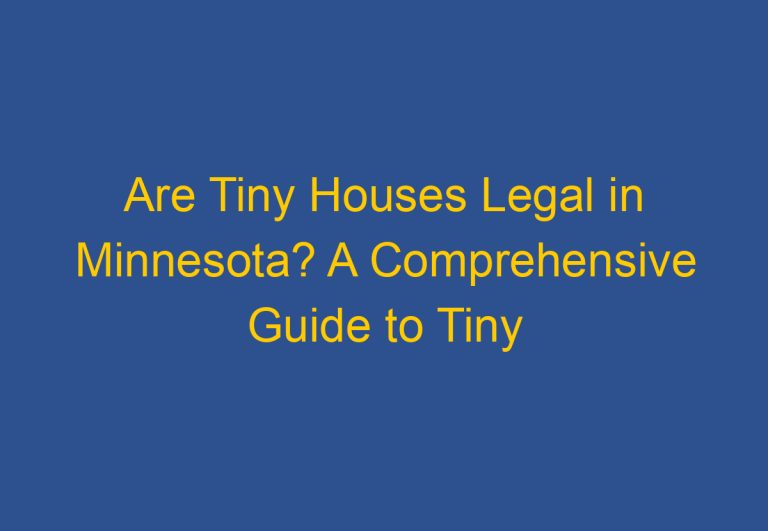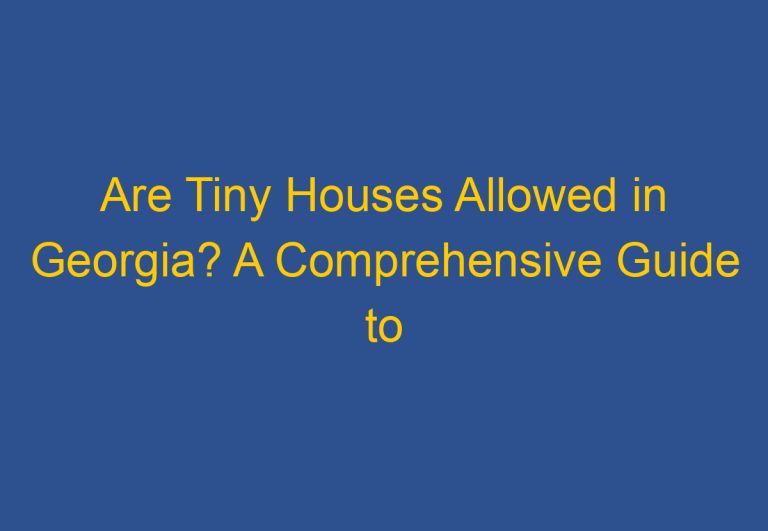Where Can You Live in a Tiny House: A Guide to Finding the Perfect Location
The tiny house movement has been gaining popularity over the years, with more people opting to downsize their living spaces and embrace a minimalist lifestyle. However, one question remains on the minds of those interested in tiny house living: where can you live in a tiny house?
The answer to this question is not always straightforward, as zoning laws and regulations vary from state to state and even from city to city. Some areas have embraced the tiny house movement and have created communities specifically for tiny homes, while others have strict regulations that make it difficult to live in a tiny house.
One option for those interested in tiny house living is to look for communities that are specifically designed for tiny homes. These communities often have zoning laws and regulations that are friendly to tiny houses, making it easier to find a place to park your tiny home. Additionally, living in a tiny house community can provide a sense of community and support for those living the tiny house lifestyle.
Legality and Zoning for Tiny Houses
For those looking to downsize and live in a tiny house, it is important to understand the legality and zoning regulations that come with it. While the tiny house movement has gained popularity in recent years, it is still a relatively new concept that is not yet fully embraced by all local governments.
Understanding Zoning Laws and Regulations
Zoning laws and regulations vary from state to state and even from city to city. In some areas, tiny houses are considered illegal and cannot be parked in most places due to local zoning laws. It is important to research the local zoning laws and regulations before deciding to live in a tiny house.
Some cities have specific zoning laws for tiny houses, while others do not. It is important to understand the zoning laws in your area to determine if it is legal to park or live in a tiny house.
Navigating Building Codes and Tiny House Standards
Building codes and tiny house standards are also important to consider when building or purchasing a tiny house. The American Tiny House Association has developed a set of standards for tiny houses to ensure they meet safety and quality standards. It is important to research and follow these standards to ensure your tiny house is legal and safe.
Additionally, building codes vary from state to state and city to city. It is important to research the building codes in your area to ensure your tiny house meets all necessary requirements.
Finding Legal Plots for Tiny House Placement
Finding legal plots for tiny house placement can also be a challenge. Some cities have tiny house communities or allow accessory dwelling units (ADUs) on properties. ADUs are small living spaces that are built on the same property as a larger home. They can be used as a guest house, rental unit, or even a primary residence.
It is important to research the local regulations and permits required for building an ADU or parking a tiny house on a property. Property taxes may also be affected by the addition of an ADU or tiny house.
In urban areas, finding legal plots for tiny house placement can be even more difficult due to limited space and zoning regulations. However, in rural areas, it may be easier to find legal plots for tiny house placement due to less strict zoning regulations.
Overall, it is important to do thorough research and understand the legalities and regulations surrounding tiny houses before deciding to live in one. By understanding zoning laws, building codes, and finding legal plots for placement, individuals can ensure their tiny house is legal and safe.
Living in a Tiny House
Living in a tiny house is a lifestyle choice that offers financial freedom, environmental sustainability, and a simpler way of life. However, it requires careful consideration and planning to ensure that it is a comfortable and practical living arrangement. In this section, we will explore some of the key factors to consider when living in a tiny house.
Choosing the Right Location and Community
When considering where to live in a tiny house, location is key. Some states such as California, Texas, Colorado, North Carolina, Arizona, Oregon, and New York have embraced the tiny house movement and offer more options for tiny house living. It is also important to consider building codes, zoning laws, and regulations for tiny homes in different states.
Living in a tiny house community can offer many benefits such as shared resources, community gardens, and social events. Some popular tiny house communities include Cedar Springs Tiny Village in Washington, Escalante Village in Colorado, and Orlando Lakefront in Florida.
Maximizing Space and Embracing Minimalism
One of the biggest challenges of living in a tiny house is maximizing space and embracing minimalism. This requires careful planning of the floor plan, storage hacks, and the use of vertical space. It is also important to consider the essentials and prioritize what is necessary for daily living.
Using natural materials and recycled materials can also help to create a more sustainable and eco-friendly living space. Appliances should be carefully chosen for their size and energy efficiency.
Financial Considerations and Benefits
Living in a tiny house can offer significant financial benefits such as reduced mortgage or rent payments, lower utility bills, and the ability to save money. However, it is important to carefully consider the cost of building or buying a tiny house, as well as the cost of maintaining and repairing it.
Financing options such as loans and grants are available for those interested in buying or building a tiny house. Accessory Dwelling Units (ADUs) and shipping containers can also be used as a more affordable alternative to traditional tiny house living.
In conclusion, living in a tiny house can offer many benefits for those seeking a simpler, more sustainable way of life. However, it requires careful consideration of location, space, and finances to ensure a comfortable and practical living arrangement.
Frequently Asked Questions
What are the zoning regulations for tiny houses in urban areas?
Zoning regulations for tiny houses can vary greatly between urban areas. Some cities have embraced the tiny house movement and have created specific zoning regulations to accommodate them. However, others have not yet caught up with the trend and may have strict zoning regulations that make it difficult to legally live in a tiny house.
Are there any states with particularly lenient laws for tiny home living?
Yes, there are some states that have particularly lenient laws for tiny home living. For example, California, Oregon, and Texas have all passed laws that make it easier for people to live in tiny homes. However, it’s important to note that even in these states, there may be specific zoning regulations that need to be followed.
How do tiny home community developments impact where you can reside in a tiny house?
Tiny home community developments can provide a great option for people who want to live in a tiny house but may not have access to suitable land or zoning regulations that allow for it. These communities often have their own zoning regulations that make it legal to live in a tiny house within the community.
What are the legal requirements for establishing a tiny house on private property?
The legal requirements for establishing a tiny house on private property can vary depending on the location. In general, it’s important to ensure that the tiny house meets all building codes and zoning regulations for the area. Additionally, it may be necessary to obtain a building permit and have the tiny house inspected before it can be legally occupied.
In which regions can you find the most affordable land suitable for tiny houses?
Affordable land suitable for tiny houses can be found in many different regions, but it’s important to do research and ensure that the land is zoned for residential use and that there are no restrictions on the size of the home that can be built. Some regions that may be particularly affordable include rural areas and small towns.
What are the considerations for living in a tiny house full-time?
Living in a tiny house full-time can be a rewarding experience, but it’s important to consider some of the challenges that come with it. These may include limited storage space, the need to downsize possessions, and the need to find suitable land or a tiny house community. It’s also important to ensure that the tiny house meets all building codes and zoning regulations for the area.










